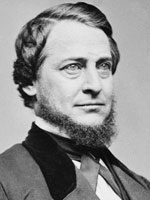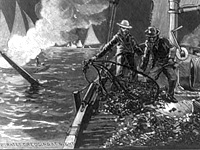Here are three possibilities about what you were told, none of which match precisely what you have described.
Before Fort Sumter
One possibility relates to the actions of Lincoln just after he assumed the presidency in 1861. By late March and early April, several southern states had seceded, but a few closer to the North—Virginia, in particular—had not. Virginia had called a Constitutional Convention to decide its course, but those in favor of remaining in the Union were in control of the convention, and this apparently accorded with public sentiment in Virginia. Nevertheless, the convention did not adjourn, so the outcome was still undecided.
During those weeks, the political and military situation was extremely volatile. The Federal army's forces at Fort Sumter in Charleston Bay and at Fort Pickens outside Pensacola needed to be relieved or reinforced, especially in the face demands from South Carolina and Florida. These two states called for the evacuation of federal soldiers at the forts, an action that would have been widely seen as a de facto recognition of the legality of their secession.
In testimony after the war at a congressional hearing, John Minor Botts and John Baldwin, both pre-war Virginia politicians and delegates to the Virginia convention in Richmond, gave contradictory testimony about Lincoln’s actions. Botts claimed that Lincoln had asked to confer with Baldwin, and that during their talk, Lincoln asked Baldwin to relay to the convention a pledge that, if it would adjourn without voting for secession, he would evacuate the federal forces from Forts Sumter and Pickens. Botts met with Lincoln several days later, he testified, and Lincoln had told him about the offer. This had alarmed Botts, who heard nothing of the offer from Baldwin. Botts claimed that Baldwin, on his own initiative, said nothing about the offer because it could have prevented Virginia’s secession. Baldwin, however, strongly denied that Lincoln had made any offer during their conversation.
if it would adjourn without voting for secession, he would evacuate the federal forces from Forts Sumter and Pickens
Nevertheless, by the time Lincoln met with Botts, he had already dispatched orders to send forces by sea to relieve Forts Sumter and Pickens, an action that South Carolina and Florida resisted by force. After the bombardment of Fort Sumter from Charleston and its fall, sentiment in Virginia and at the convention shifted dramatically, and Virginia seceded.
In the hearing, Botts—who was a Unionist before and throughout the war—said that Lincoln’s offer elevated the president’s reputation as a statesman who was genuinely seeking peace and the preservation of the Union. The Radical Republicans who presided over the hearing, however, were troubled by the idea that Lincoln had made such an offer, because, from their point of view, it would suggest that he had been willing to “offer a bribe to Treason.”
Historian Nelson Lankford points out that Lincoln may have been pursuing more than one course during the first weeks of his presidency, before hostilities erupted. He was criticized in the press for indecision, but in fact he had been working to resolve conflicting advice within his cabinet. His secretary of state, William Seward, in particular, advocated resolving the issue through negotiation, rather than by force.
During the War
Another possibility relates to the presidential election of 1864, when the Democrats nominated General George B. McClellan. The party's platform called for an end to prosecuting the war and a truce with the Confederacy, which would have ended the war by allowing the secession of southern states. McClellan himself did not agree with this and advocated continuing the war. Because the war had not been going well for the North, the Democrats might have won the election, but Union victories close to election day bolstered the Republicans, and Lincoln was re-elected.
The Democrats' "peace plank" had declared the war a failure and promised to end hostilities. Its author was Clement Laird Vallandigham (a photo of him is at the top of the page), an Ohio politician who was arrested, tried, and convicted by a military tribunal the previous year for "disloyal" statements. Instead of serving time in jail, he was exiled south by Lincoln. From there he traveled to Canada and accepted the Ohio democratic nomination for governor in absentia. During his campaign, which he ran from a hotel room in Canada, he pledged, if elected, to withdraw Ohio from the Union unless Lincoln ceased hostilities with the Confederacy.
he pledged, if elected, to withdraw Ohio from the Union unless Lincoln ceased hostilities with the Confederacy
Vallandigham lost the election in a landslide, but continued to be influential in the Democratic Party. If McClellan had won the 1864 presidential election, many Democrats were determined that Vallandigham should serve as secretary of war.
At the End of the War
A third possibility relates to the closing days of the war. Radical Republicans in congress as well as Secretary of War Edwin Stanton became concerned that Lincoln would allow the confederate states back into the Union without punishing them or forcing them to outlaw slavery.
the legislature would be recognized as the de facto government of the state
Their fears seemed well-founded when they learned that Lincoln, during a trip to Richmond after its fall, early in April 1865, consulted with at least one Virginia politician and had informally encouraged him to help reconvene the Virginia legislature, declare the state's loyalty to the Union, and order Virginia's soldiers to lay down their arms. In return, said Lincoln, the legislature would be recognized as the de facto government of the state and it could begin to restore order. Republicans viewed Lincoln's offer as an attempt to usurp the power of Congress and as a "bribe of unconditional forgiveness." The point soon became moot, however, by Lee's surrender of his army at Appomatox. The Virginia Legislature did not reconvene.

 Oysters became a high-demand source of protein and nutrition following the Civil War. With the rise of industry and of shipping by rail, canneries and corporate oyster farming operations sprang up on both coasts, eager to supply the working class, and anyone else who wanted the tasty shellfish, with oysters shipped live or canned. In San Francisco, a center of oyster piracy, the boom years of the oyster industry corresponded, unsurprisingly, with those of the oyster industry—both took off in 1870, as the state began allowing major oyster farming operations to purchase the rights to underwater bay "land" (traditionally common property), and petered off in the 1920s, as silt and pollution disrupted the bay's ecosystem.
Oysters became a high-demand source of protein and nutrition following the Civil War. With the rise of industry and of shipping by rail, canneries and corporate oyster farming operations sprang up on both coasts, eager to supply the working class, and anyone else who wanted the tasty shellfish, with oysters shipped live or canned. In San Francisco, a center of oyster piracy, the boom years of the oyster industry corresponded, unsurprisingly, with those of the oyster industry—both took off in 1870, as the state began allowing major oyster farming operations to purchase the rights to underwater bay "land" (traditionally common property), and petered off in the 1920s, as silt and pollution disrupted the bay's ecosystem. At 15, Jack London bought a boat, the Razzle Dazzle, and joined the oyster pirates of San Francisco Bay to escape work as a child laborer. London wrote about his experiences in his semi-fictional autobiography, John Barleycorn, and used them in his early work, The Cruise of the Dazzler, and in his Tales of the Fish Patrol. The latter tells the story of oyster pirates from law enforcement's perspective—after sailing as an oyster pirate, London switched sides himself, to hunt his former compatriots.
At 15, Jack London bought a boat, the Razzle Dazzle, and joined the oyster pirates of San Francisco Bay to escape work as a child laborer. London wrote about his experiences in his semi-fictional autobiography, John Barleycorn, and used them in his early work, The Cruise of the Dazzler, and in his Tales of the Fish Patrol. The latter tells the story of oyster pirates from law enforcement's perspective—after sailing as an oyster pirate, London switched sides himself, to hunt his former compatriots. The working class romanticized oyster pirates as Robin-Hood-like heroes, fighting back against the new big businesses' private control of what had once been common land. Traditionally, underwater "real estate" was commonly owned—anyone with a boat or oyster tongs could fish or dredge without fear of trespassing. Following the Civil War, states began leasing maritime "land" out to private owners; and the public protested, by engaging in oyster piracy, supporting oyster pirates, scavenging in tidal flats and along the boundaries of maritime property, and, occasionally, engaging in armed uprisings.
The working class romanticized oyster pirates as Robin-Hood-like heroes, fighting back against the new big businesses' private control of what had once been common land. Traditionally, underwater "real estate" was commonly owned—anyone with a boat or oyster tongs could fish or dredge without fear of trespassing. Following the Civil War, states began leasing maritime "land" out to private owners; and the public protested, by engaging in oyster piracy, supporting oyster pirates, scavenging in tidal flats and along the boundaries of maritime property, and, occasionally, engaging in armed uprisings.  The opera satirized Governor William Evelyn Cameron's second raid against oyster pirates in the Chesapeake Bay, on February 27, 1883. Cameron had conducted a very successful raid the previous February, capturing seven boats and 46 dredgers, later pardoning most of them to appease public opinion—which saw the pirates as remorseful, hard-working family men. His second raid, in 1883, went poorly. Almost all of the ships he and his crews chased escaped into Maryland waters, including the Dancing Molly, a sloop manned only by its captain's wife and two daughters (the men had been ashore when the governor started pursuit). The public hailed the pirates as heroes and ridiculed the governor in the popular media—the Lynchberg Advance, for instance, ran a
The opera satirized Governor William Evelyn Cameron's second raid against oyster pirates in the Chesapeake Bay, on February 27, 1883. Cameron had conducted a very successful raid the previous February, capturing seven boats and 46 dredgers, later pardoning most of them to appease public opinion—which saw the pirates as remorseful, hard-working family men. His second raid, in 1883, went poorly. Almost all of the ships he and his crews chased escaped into Maryland waters, including the Dancing Molly, a sloop manned only by its captain's wife and two daughters (the men had been ashore when the governor started pursuit). The public hailed the pirates as heroes and ridiculed the governor in the popular media—the Lynchberg Advance, for instance, ran a  Oyster piracy highlights the class tensions that sprang up during post-Civil War industrialization. Big business and private ownership began to drive the economy, shaping the lives of the working class and changing long-established institutions and daily patterns. Young people such as Jack London turned to oyster piracy as an escape from the new factory work—and the working class chaffed against the loss of traditional maritime common lands to business owners.
Oyster piracy highlights the class tensions that sprang up during post-Civil War industrialization. Big business and private ownership began to drive the economy, shaping the lives of the working class and changing long-established institutions and daily patterns. Young people such as Jack London turned to oyster piracy as an escape from the new factory work—and the working class chaffed against the loss of traditional maritime common lands to business owners.
